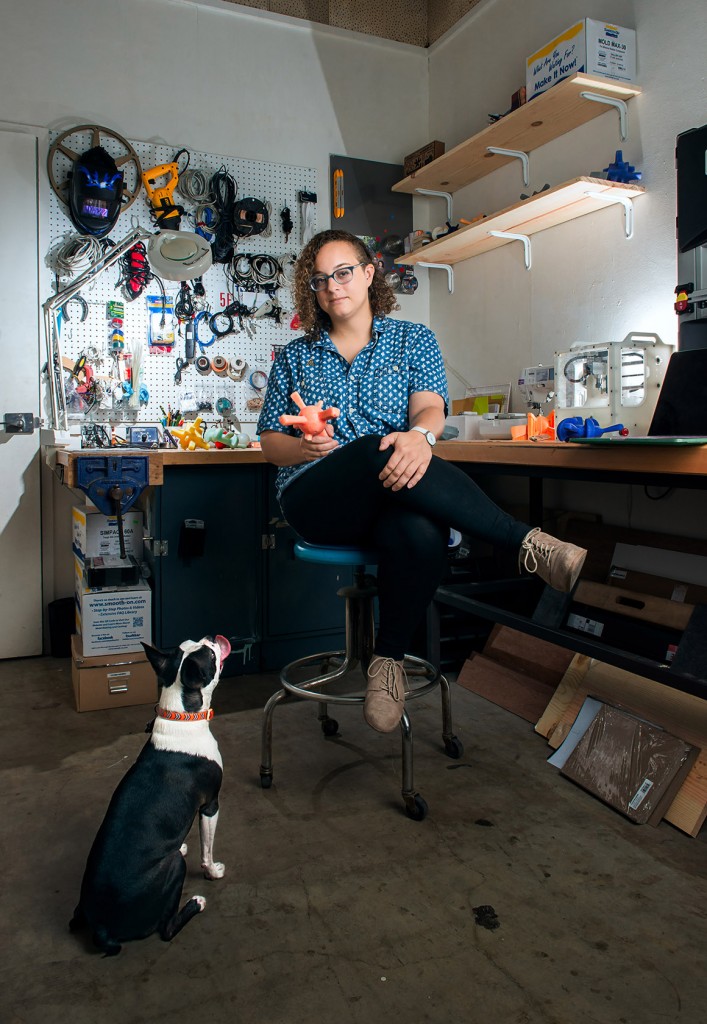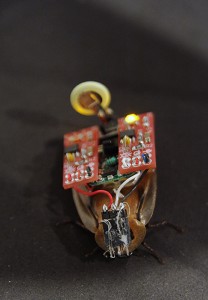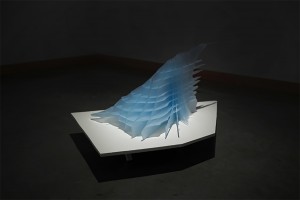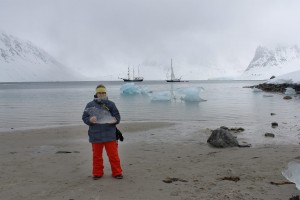Hacking the Code
Assistant Professor Brittany Ransom’s work in the College of the Arts explores the relationship humans have with technology. More accurately, it explores the increasingly blurred lines between human, animal and environmental relations through technology. Her current work is turning the world of dog toys on its head, both aesthetically and functionally.
For The Dogs
Her current work took her to San Francisco in the summer where she participated in the prestigious Workshop Residency to bring her idea for a groundbreaking dog toy to life.
The Jaw Jabbler, as Ransom named the set, is a series of three aesthetically pleasing and/or high-tech devices that enable dog owners to better communicate with their canine companions while embracing modern design.

Building upon a reprogrammable toy prototype she developed in 2010, Ransom has enhanced the use of soft circuit technology in her current research by developing an electronic tool for dogs that will enabled them to communicate.
“In a way I’ve been waiting for technology to catch up and become small enough and cheap enough that I can make a series of toys that all have different functions,” Ransom said.
The new series of toys is made of both soft-circuited materials and cast pet-safe rubber. The first is an updated version of the prototype, meant as both a toy and a training aid.
“The idea is that this toy has nodules or arms that, depending on which one they squeeze, the dog might be able to ask for something, as in ‘I’m hungry’ or ‘I want to go for a walk.’ And the owner may be able to communicate back—hopefully as a training tool,” Ransom said. “I think it could be particularly useful for service dogs.”
The second in the series is another tech toy that allows dogs to create drawings, depending on their movement and interaction with it.
The third is a tech-free toy that grew out of Ransom’s appreciation for design. “I’m really particular about space and objects and I just hate the way most dog toys look,” Ransom said.
Ransom, who received her Master of Fine Arts Degree from the University of Illinois at Chicago in 2011, joined CSULB last fall after serving as an assistant professor of Digital/Hybrid Media and Video Art at Southern Methodist University in Dallas.
“I love the research possibilities here, I love that there is a really wide group of faculty that is interested in different things, and I think accessibility to one another seems really open,” Ransom said of CSULB.
Getting Buggy
Ransom’s previous work has utilized technology and human interaction in ways that challenge how we interact with technology. One example was her interactive art project Tweet Roach.

When the correct combination of mentions and hashtags has been tweeted by a user through a phone or computer, Tweet Roach wirelessly would send a command to the “RoboRoach” interface attached to a cockroach in order to stimulate one of its two antennae connected to the circuit. This essentially made the insect feel as if its antennae had touched something. The received tweets and hashtags presumably guided the cockroach to move through space.
Iced Out
In 2014, Ransom participated in The International Arctic Circle Residency program during the Summer Solstice Exhibition. The unique and highly competitive annual expeditionary residency program brings together international artists of all disciplines–scientists, architects and educators who collectively explore remote and fascinating destinations aboard a specially outfitted sailing vessel traveling near the North Pole.


“I went up there with all of this equipment and quickly realized that as connected as I am to technology, that when there’s no Internet, there’s no support. It’s so cold there that batteries freeze and my cell phone became nothing more than a pocket sized camera, so I started using it as a 3D scanner, and then later 3D printed them,” Dr. Ransom said of the 3D glacier models.
The project took a turn and became a rather symbolic look at how long glaciers live and how long our media lives.
“I was curious as to what happens with the data loss with the cell phone as a means of collection or observation. Our images go through these systems and they get degraded and shuffled around” Ransom said.
Ransom will continue to bring that unique mix of aesthetic and technology to her work, wherever it takes her.